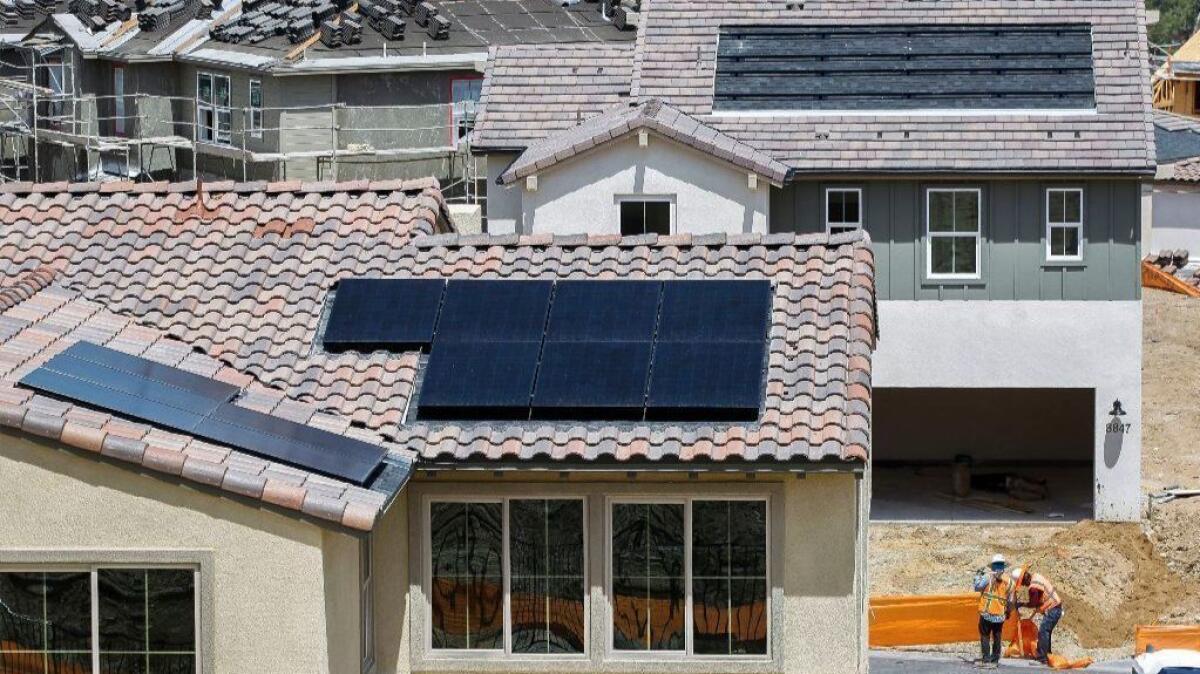Capitol Journal: California is the first state to require solar panels on new homes. Here’s why Big Brother is on to something

- Share via
Reporting from Sacramento — When a state regulatory body decrees that all new homes must have rooftop solar starting in 2020, my temperature rises.
Big Brother is intruding too deeply into my personal life, I’m thinking. Shouldn’t it be my call alone whether to invest in solar panels, perhaps incentivized by state tax credits or rebates?
Should solar buying be simply mandated by a government bureaucracy without even a vote by our elected representatives in the Legislature?
One additional very real concern: California is mired in a housing crisis. Buying a home already is unaffordable for far too many families. And now the state is going to add the cost of a rooftop solar system to every new home purchase, like it or not.
The latest median price for a home in this state is $538,640, according to the California Assn. of Realtors. The minimum annual income required for a mortgage is $111,500, the Realtors say. Only 31% of households can afford that.
That’s more than double the national median: $245,500 is the median price nationally, with a $50,820 income needed to qualify — and 57% of households can.
In the Los Angeles metropolitan area, the median price is $500,000 and the minimum income required is $103,500. In the San Francisco Bay Area, it’s $900,000 and $186,300.
For many years, housing construction in California has fallen far short of keeping up with population growth. Last year, 114,476 units were built. We needed 180,000 to keep pace with rising population.
There are many reasons for all this. Start with high land costs, especially along the coast. There are labor shortages. NIMBY — “not in my backyard” — zealots fight nearby developments. Environmental regulating drags on interminably, driving up project costs. For decades after Proposition 13 lowered property taxes, cities discouraged new housing and favored commercial projects that generated sales taxes.
Now there’s a new, intrusive cost driver: the solar edict.
Those were my initial knee-jerk thoughts. Sacramento, get off my back.
Coverage of California politics »
I still feel this way, but after more thought I have concluded that perhaps forcing all buyers of new homes to go green is prudent, desirable and inevitable.
Its impact on housing affordability will be minimal, if the California Energy Commission’s figures are correct.
The commission, appointed by the governor, recently voted 5 to 0 to require solar panels on single-family homes and multifamily buildings up to three stories. It was the first time any state has done that.
The average cost per home for solar was estimated at $9,500. But over a 30-year mortgage, the commission projected $19,000 in energy savings. The panels will add about $40 a month to the mortgage but save $80 a month in heating, cooling and lighting costs.
At least that’s the government’s estimate. Who knows how it will turn out?
Economics aside, we do need to cut back further on greenhouse gas emissions. They’re produced by burning fossil fuel, such as natural gas in home furnaces and water heaters — and in huge power plants that generate electricity for air conditioners and televisions. Those emissions escalate the global warming that is reducing the snowpack we’ve historically relied upon for water storage and clean hydroelectric power.
Buildings account for 25% of our greenhouse gas emissions. Homes built under the commission’s new solar and other efficiency standards are expected to use half as much energy as homes built in 2016 without panels. The agency says that will be the equivalent of taking 115,000 gas-burning cars off the road.
It wasn’t too long ago — roughly 18 years — when electricity shortages in California were causing brownouts, and we were desperate. Out-of-state power pirates were robbing us. Rooftop solar is one answer to guarding against ever being victimized again.
But if we’re going that far and targeting home buyers, we should think about a truly bold move. Here’s a twofer that would generate renewable energy and save water.
There are tens of thousands of acres in the parched San Joaquin Valley that would make excellent solar farms. Right now, they’re growing almonds and pistachios for export to Asia. One little almond needs a gallon of water to grow.
Agriculture soaks up 80% of California’s developed water. Only 20% goes to domestic and industrial uses. Plus, for decades, farmers have been sucking up aquifers, and the land is sinking, cracking canals and roads.
The state should regulate agricultural land — as it does most all other land — and carve out patches for solar farms. Buy up the orchards that are feeding China. Convert them to renewable energy production.
That’s not possible now — it’s political poison. But as the snowpack falls and the population rises, it may be as inevitable as rooftop solar.
The California Building Industry Assn. saw rooftop solar as inevitable several years ago and instead of trying to fight it, worked with the commission on developing a cost-efficient, consumer-friendly plan.
“When we started, they believed it would cost nearly $50,000 per home,” says Dan Dunmoyer, president of the association. “We ended up at under $10,000.”
OK, but don’t cut corners installing those panels on a roof. Make sure they’re bolted properly. I’ve had to replace two roofs prematurely because they’ve been devoured by solar for my pool. The technology’s better now, I’m told.
Big Brother also should help home buyers with state tax write-offs. Don’t hold your breath.
Follow @LATimesSkelton on Twitter
More to Read
Get the L.A. Times Politics newsletter
Deeply reported insights into legislation, politics and policy from Sacramento, Washington and beyond. In your inbox twice per week.
You may occasionally receive promotional content from the Los Angeles Times.











